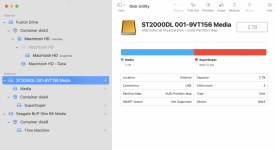- Joined
- Jun 24, 2011
- Messages
- 220
- Reaction score
- 2
- Points
- 18
- Location
- Brighton
Until today I used a 2TB mains powered external drive for regular Time Machine backups and weekly SuperDuper manual updates, partitioned equally.
In an effort to save some energy I have now transferred the Time Machine backups to a solid-state drive and renamed the partition “Media” where I have stored old photos and music. This is so I can leave the drive switched off until I need to update SuperDuper or access the media.
While it’s not necessary at the moment I want to reduce the size of the Media partition to 500 Gb and increase the SuperDuper to 1.5 Tb, I have tried to do this in Disk Utility but it will not allow me to. If I reduce the Media partition it creates a new Untitled partition and will not allow me to increase the SuperDuper partition.
Can anyone tell me how to achieve this please? Sorry for the long question.
Screenshot attached, thanks.
In an effort to save some energy I have now transferred the Time Machine backups to a solid-state drive and renamed the partition “Media” where I have stored old photos and music. This is so I can leave the drive switched off until I need to update SuperDuper or access the media.
While it’s not necessary at the moment I want to reduce the size of the Media partition to 500 Gb and increase the SuperDuper to 1.5 Tb, I have tried to do this in Disk Utility but it will not allow me to. If I reduce the Media partition it creates a new Untitled partition and will not allow me to increase the SuperDuper partition.
Can anyone tell me how to achieve this please? Sorry for the long question.
Screenshot attached, thanks.





